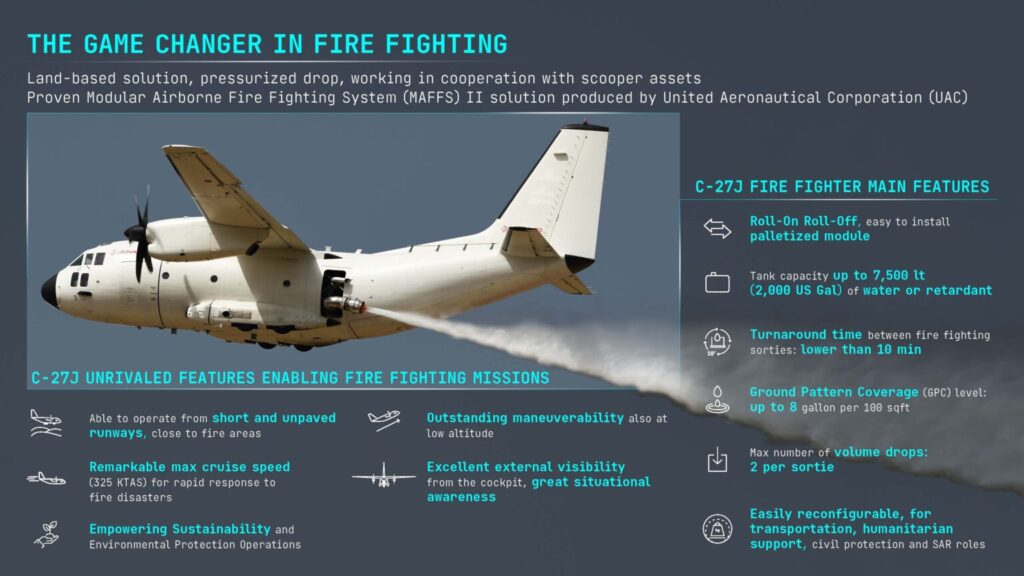By: John Adler
Leonardo has introduced an advanced, cutting-edge solution to tackle the growing challenge of wildfires with its C-27J Next Generation “Fire Fighter.” This twin-engine turboprop aircraft is designed to complement helicopters and amphibious scooper aircraft that collect water directly from natural water sources. The standout feature of the C-27J Fire Fighter is its second-generation MAFFS II (Modular Airborne Fire Fighting System). This modular system, which can be installed or removed in just 90 minutes, includes a 7,500-liter tank capable of being refilled in under 10 minutes and a nozzle that deploys through the fuselage for precise water and retardant dispersion.
Aligned with Leonardo’s Environmental Sustainability Plan, the aircraft uses a fire-retardant liquid, Phos Chek 259 FX, which is eco-friendly and certified as non-polluting and safe for humans, animals, and the environment. Derived from ammonium polyphosphates commonly used in agriculture, the solution meets stringent European safety standards and offers an environmentally responsible approach to firefighting operations.

The C-27J excels in challenging conditions, operating at low altitudes and in adverse weather. Agile, fast, and equipped with state-of-the-art digital avionics, the aircraft boasts a top speed of 325 knots (602 km/h) and Short Takeoff and Landing (STOL) capabilities, allowing it to operate from semi-prepared runways near fire zones. Its ability to respond quickly and effectively to emergencies in remote locations sets it apart, especially in areas with limited water resources or rough seas where scooper aircraft may struggle. The aircraft can release a pressurized stream of water mixed with retardant at speeds of 130 knots (250 km/h), covering extensive ground with each drop and adapting to the terrain’s specific challenges.
This platform goes beyond firefighting, offering multi-mission capabilities for disaster prevention, emergency response, humanitarian aid, and search-and-rescue missions. Designed for flexibility and cost-effectiveness, the C-27J’s modular systems enable year-round utilization, reducing operational costs and maximizing value.
A recent demonstration in Italy showcased the aircraft’s capabilities. The event included real-world drops at Taranto-Grottaglie and Manduria, highlighting the effectiveness of the MAFFS II system and the operational readiness of the C-27J Fire Fighter.
Leonardo’s C-27J Spartan Next Generation continues to build on its legacy as a versatile tactical transport aircraft. Its new features, including upgraded digital avionics, enhanced aerodynamic components like winglets, and increased maximum takeoff weight (up to 32,500 kg), elevate its operational performance. The Spartan’s robust structure and system redundancy ensure reliability and resilience in demanding conditions.
Equipped with two powerful turboprop engines, the C-27J delivers unmatched performance, agility, and efficiency for tactical transport and emergency missions. Capable of operating on unpaved runways with minimal infrastructure and in extreme temperature ranges from -55°C to +50°C, the aircraft is designed to handle the most challenging scenarios. With superior climbing and descent rates, tactical maneuverability, and STOL capabilities, the C-27J is an exceptional solution for fire suppression, disaster response, and military transport needs, proving its value to air forces and civil operators worldwide.

